NEWS 2012-
News
Ethiopia-Japan industrial policy dialogue since 2008 (March
2021)
In July 2008, Prime Minister Meles of Ethiopia requested JICA's kaizen cooperation and policy discussion with GRIPS. Since then, bilateral policy dialogue has been conducted regularly. Many policy proposals have been followed by concrete industrial projects including JICA's export and FDI promotion, establishment of JETRO office, etc.
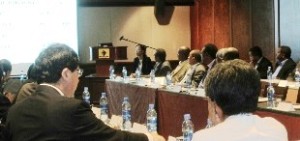
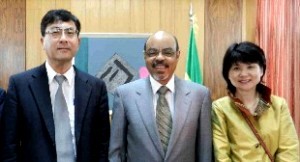
High Level Forum with ministers and state ministers / Prime Minister Meles Zenawi
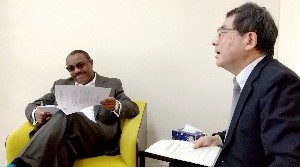
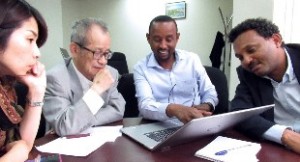
Prime Minister Hailemariam Desalegn /
At PSI, a government policy think tank
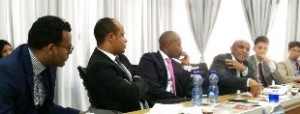
At Ethiopian Investment Commission /
Inviting metal institute officials to Saitama, Japan
Ethiopia exports roses
(June 2019)
Ethiopia and Kenya compete for marathon and flower export. Ethiopian flower industry is still young and both FDI and local firms produce and ship fresh roses to Europe, Middle East, etc. by air. A small amount also comes to Japan. The GRIPS policy dialogue team visited ET Highland, a local rose farm near Addis Ababa, in June 2019.
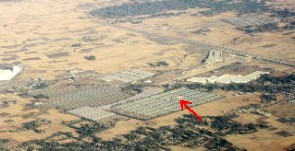
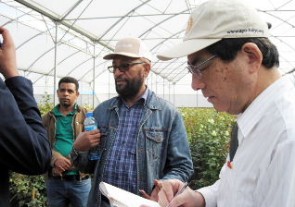
Aerial view of the farm: 30ha with 31 green houses; daily shipment of
80,000-100,000 cut roses.
Mr. Tsegaye Abebe (CEO) kindly took us around the farm and explained
everything. He was also the founder of Ethiopian Horticulture
Association.
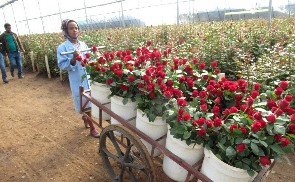
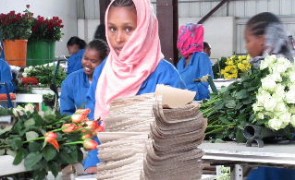
560 mostly female workers pick and carry roses to pack house. Wage is
$54/mo. at minimum, plus bonuses for performance, non-absenteeism and
long service. Annual labor turnover is 10%. At pack house, roses are chilled, cut, wrapped and boxed for shipment.
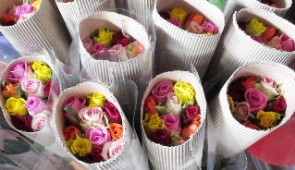
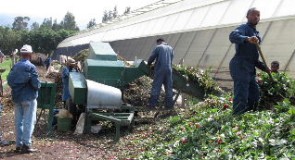
Each bunch contains 20 flowers as specified by customers regarding
species, colors, length, color of wrapping, etc.
Rose wastes are converted to compost (organic fertilizer). Waste water
is bio-treated for environmental protection.
Vietnam Then & Now
(June 2018)
I have been going to Vietnam since 1995, over 200 times, for policy research. I helped Vietnamese kids to go to school and now live with some of them when in Hanoi. Here are photos of Hanoi to show how the city changed in the last 23 years. But the mindset of Vietnamese people and officials are slower to change, for better or worse.
1995 - bicycles dominate Hanoi streets / 1996 - Izumi, me & street sellers at Hoan Kiem Lake - two of them
are now my daughters
1996 - motorcycles increase but without helmets /
2005 - a city very densely built but few high rises
Now - high-rise dwellings are emerging everywhere; an urban rail is
being built above /
Too many apartments in Western Hanoi
Times City - a huge underground shopping center /
AEON Malls are increasing across Vietnam
Streets are still chaotic & few observe traffic rules; most now wear
helmets, but not everyone /
On weekends Hanoi center is closed to traffic
Flowers from April to June
(July 2017)
Sakura is not the only flower you can enjoy in Tokyo - and the rest of Japan - during the Spring Quarter at GRIPS.
Mokuren (magnolia) / sakura (cherry blossoms) in Ueno Park
Yaezakura (multi-petal cherry blossoms) / fuji (wisteria) hanging from a shelf
Tsutsuji (azelea) blooms in red, pink & white / gaku ajisai (hydrangea)
Fuyo (cotton rose)
Okinawa
(April 2017)
Okinawa Main Island was a fierce battle field toward the end of WW2. The US occupied Okinawa from 1945 to 1972 when it reverted to Japan. It still hosts many US bases. Okinawa with beautiful coral reefs is also a favorite tourist destination.
Kokusai Dori, the main street, is crazy and fun/Cornerstone of Peace, remembering war victims.
Lanai Kanai Bridge and coral reefs/Nakijin Gusk (Castle). Satsuma Han attacked and burned this castle in
1609.
Okinawa noodles/A fighter taking off from Kadena US Air Base.
Makishi Public Market No.1 sells colorful fish/A guestroom with tatami mats,
4,800 yen per person without meals. But there is an excellent local
restaurant next door.
Ethiopia on the move
(May 2016)
Ethiopia is a poor country with pc income of $550 (2014, World Bank) but growing fast and aiming to attain lower middle income by 2025. Government is serious about building infrastructure and changing the national image. Below are some of the progress or achievements observed in 2015-2016.
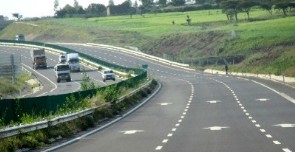
Addis Ababa-Adama Expressway - 85km already operational

New Addis Ababa-Djibouti 656km railway under test-run and expected
to be in operation in 2016

Addis Ababa's urban light rail (North-South Line & East-West Line), the
first of its kind in Africa, started running in 2015
The above three transport projects were built by China. Ethiopia knows how to mobilize China's (and other countries') cooperation to its advantage.
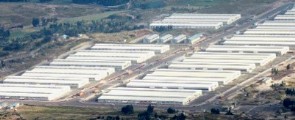
Bole Lemi Industrial Zone - Ethiopia's first state-owned and managed IZ
already full & operational
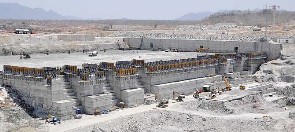
Grand Renaissance Dam on the Blue Nile, 55% finished, will generate
6,000MW when completed, supplying power even to neighboring countries.


Strawberry production & export began by an Israeli firm in Mojo, south
of Addis Ababa

JICA assisted the creation of "Ethiopian
Highland Leather" brand for high-end sheepskin products

Rift Valley Wine, the first Ethiopian wine produced by a French winery,
went on sale in 2015
Private Schools in Edo Period (May 2015)
During the Edo Period (1603-1867), Bakufu (central government) neither regulated nor promoted private education. As a result, many private schools emerged for both adults and children. Some schools were run by top scholars which made a mark on Japanese intellectual history and/or produced young political leaders (photos by Ohno).
Toju Shoin (Takashima, 1639?, teacher: Nakae Toju) taught how
people should live, behave & interact, and produced many followers.
Kangien (Hita, 1817, founder: Hirose Tanso) taught Confucianism
under strict discipline & grading, and attracted many students from all over Japan.
Teki Juku (Osaka, 1838, teacher: Ogata Koin) taught Dutch
language & western medicine. Fukuzawa Yukichi, founder of Keio University,
studied here.
Shokason Juku (Hagi, 1855, teacher: Yoshida Shoin) was a
discussion forum among enthusiastic & politically active students. It
existed only for 2 years but produced 2 prime ministers.
Industrial policy & middle income traps
(Jun. 2014)
The age of PRSP and aid harmonization seems over. Even MDGs are less talked about. WB, WTO, UN Group and regional organizations are keen on debating industrial policy and middle income traps for receiving attention and budget. This shift was partly due to the rise of East Asian donors with more real-sector oriented agenda.
Expert meeting on middle income countries sponsored by
UNDP (Seoul)
Communist Party Economic Committee meeting on Vietnam's
middle income trap problem (Hanoi)
Definition of a middle income trap?
- Growth slows down at middle income and does not achieve
high income (too general)
- If a country stays in middle income for 28 (or 50) years, it is
considered trapped (too technical & backward looking)
- It is a situation where a country is stuck at an income level
associated with given resources and advantages, and cannot rise higher
because value is not created by domestic citizens or firms - just luck
and no effort (my definition)
WTO's expert meeting on industrial policy and the trade
system (Beijing)
Joe Stiglitz, Justin Lin & Ha-joon Chang are economists criticizing
IMF/WB/WTO and advocating active industrial policy (Johannesburg)
Ethiopia meets Malaysia
(Jun. 2013)
JICA & GRIPS invited Ethiopian industrial state ministers and FDI agency officials to visit Malaysia to learn from their policy making - total of 11 people from Ethiopia for two weeks.
Ethiopians are serious people - every morning they have a pre-meeting at
the hotel lobby/SME Corp. Malaysia - key officials are ladies
At the Ministry of International Trade & Industry/meeting with MITI minister
Malaysian MITI complex/Mr.
J.Jegathesan - former MIDA vice director and energetic advisor to
Zambia & other governments
Manufacturing in Ethiopia
(Jun.2013)
Ethiopia is poor but government is determined to learn from East Asia and industrialize. Recently, large-scale labor-intensive projects are beginning to arrive. Since 2008, GRIPS Dev. Forum & JICA have conducted policy dialogue with Ethiopia.
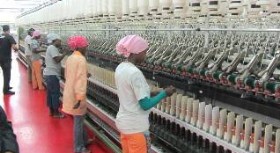
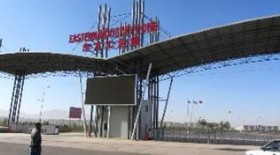
Ayka is a huge integrated textile factory from Turkey
with brand-new equipment and over 5,000 workers, producing middle-range knit products for EU
& US markets (through a German distributor)./The
Eastern Industry Zone, south of Addis Ababa, was built by a private Chinese
company, waiting for more investors.
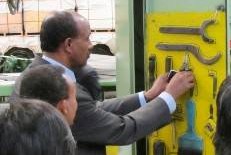
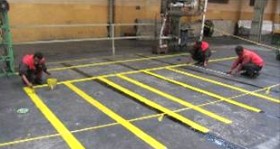
JICA-assisted kaizen activities at a local tire
manufacturer.
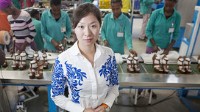
Ms. Helen Hai is CEO at Huajian Addis, a Chinese shoe
maker. The firm hires 1,750 workers,
exports Western brand shoes (OEM), and is expanding capacity.
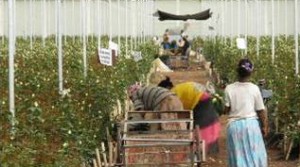
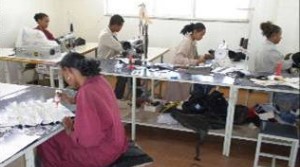
Large-scale cut-rose cultivation for export./Leather product workshop (bags, purses, wallets).
Kaizen in India
(Mar.2013)
Kaizen means improvement in Japanese. It is quality and productivity philosophy & tools created in the late 1950s by modifying US production management. Its features waste elimination, organized workplace, small and continuous improvements and teamwork. Kaizen is practiced and taught globally, often with JICA assistance.
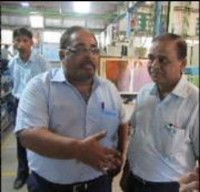
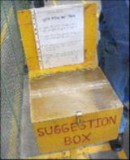
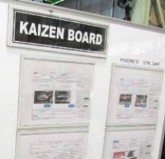
Kaizen in India is purely private, introduced by Maruti Suzuki (Japanese
JV) and its suppliers to improve car quality. Indians can now practice
kaizen perfectly without any help from Japanese.
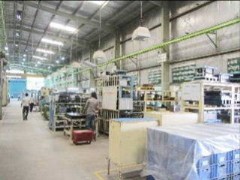

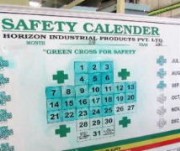
Ajisai and asagao
(July 2012)
In the rainy season (June-July), ajisai (hydrangea) bloom in many places in blue, purple, pink, white, etc. With each rain, the color of ajisai is said to deepen.
Asagao (morning glory) is another popular summer flower in
different colors grown in pots since the Edo period.